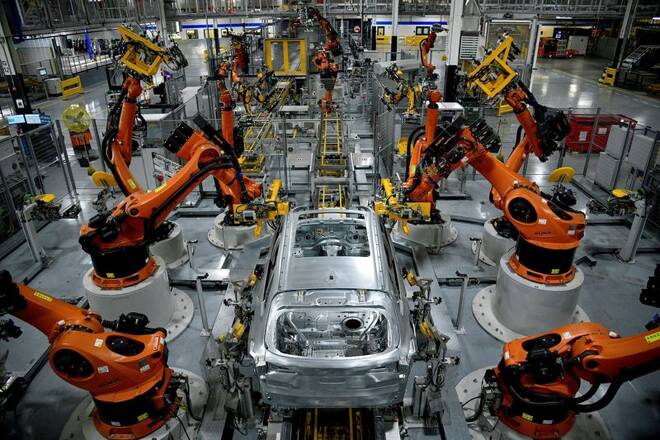Advertisement
Advertisement
US manufacturing sector contracts again; raw material prices rise
By:
WASHINGTON (Reuters) - U.S. manufacturing contracted for a fourth straight month in February, but there were signs that factory activity was starting to stabilize, with a measure of new orders pulling back from more than a 2-1/2 year low.
By Lucia Mutikani
WASHINGTON (Reuters) -U.S. manufacturing contracted for a fourth straight month in February, but there were signs that factory activity was starting to stabilize, with a measure of new orders pulling back from more than a 2-1/2-year low.
The Institute for Supply Management survey on Wednesday also showed prices for raw materials increasing last month, suggesting inflation could remain elevated after monthly consumer and producer prices surged in January.
“Manufacturing continues to contract but not at a sufficiently rapid pace to suggest a recession in the overall economy at this point, while prices of raw materials appear to have risen,” said Conrad DeQuadros, senior economic advisor at Brean Capital in New York.
The ISM’s manufacturing PMI was little changed at a reading of 47.7 last month from 47.4 in January. Economists polled by Reuters had forecast the index would rise to 48.0. A PMI reading below 50 indicates contraction in manufacturing, which accounts for 11.3% of the U.S. economy.
Only four industries, including transportation equipment and electrical equipment, appliances and components, reported growth last month. Paper products, textile mills, furniture and related products as well as nonmetallic mineral products, computer and electronic products were among the 14 reporting contraction.
But the worst could be over for manufacturing. So-called hard data on factory production was solid in January, while business spending on equipment appeared to have rebounded at the start of the first quarter. Comments from some manufacturers in the ISM survey were supportive of this thesis.
Sluggish orders
Makers of computer and electronic products reported a “good start to the year for bookings.” Transportation equipment manufacturers said “sales remain solid, and most assembly plants are running at capacity.” Primary metals producers described business conditions as “still strong” but noted that “inventory has exceeded our planned levels.”
But food manufacturers said they expected “the first half of 2023 in the U.S. to be slower than the second half.”
With the Federal Reserve expected to keep hiking interest rates, a quick turnaround in manufacturing is unlikely. Manufacturing is also being undermined by the dollar’s past appreciation against the currencies of the United States’ main trade partners and softening global demand.
The ISM survey’s forward-looking new orders sub-index improved to 47.0 last month from 42.5 in January, which was the lowest reading since May 2020. Timothy Fiore, chair of the ISM Manufacturing Business Survey Committee, said “new order rates remain sluggish due to buyer and supplier disagreements regarding price levels and delivery lead times.”
There was also an improvement in order books, though the backlog of unfinished work remained low. The survey’s measure of supplier deliveries was little changed at 45.2, the fastest supplier delivery performance since March 2009. A reading below 50 indicates faster deliveries to factories.
Stretched supply chains early in the COVID-19 pandemic were one of the major drivers of inflation last year. Despite improving supply and softening demand, inflation flared up.
The ISM survey’s measure of prices paid by manufacturers rebounded to 51.3 in February from 44.5 in January, breaking above the 50 mark for the first time in five months.
“This is a potential concern to the extent that it signals that recent economic resilience is putting renewed upward pressure on inflation,” said Andrew Hunter, deputy chief U.S. economist at Capital Economics. “But that index is still consistent with a sharp fall in the headline CPI rate.”
Its gauge of factory employment fell to 49.1 from 50.6 in January. But that measure, which has swung up and down, has not been a good predictor of manufacturing payrolls in the government’s closely watched employment report. Factory payrolls have mostly grown at a solid clip.
(Reporting by Lucia Mutikani; Editing by Chizu Nomiyama and Paul Simao)
About the Author
Reuterscontributor
Reuters, the news and media division of Thomson Reuters, is the world’s largest international multimedia news provider reaching more than one billion people every day. Reuters provides trusted business, financial, national, and international news to professionals via Thomson Reuters desktops, the world's media organizations, and directly to consumers at Reuters.com and via Reuters TV. Learn more about Thomson Reuters products:
Latest news and analysis
Advertisement
